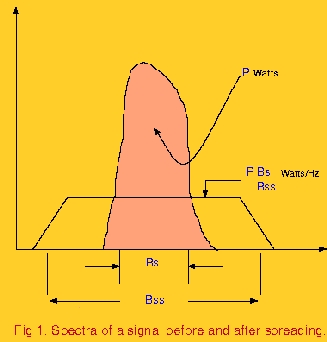|
Spreading Spectrum Characteristics |
The idea behind spread spectrum is to transform a signal with
bandwidth Bs into a noise-like signal of much larger bandwidth Bss. This
is ilustrated in the fig 1, where the vertical axis is power spectral
density (watts/hertz) and the horizontal is the frequency axis (hertz). It
can be assumed that the total power transmitted by the spread-spectrum
signal is the same as that in the original signal.

Fig 1: Spectra of a signal before and after
spreading
In this case, the power spectral density of the spread-spectrum signal is
Ps(Bs/Bss); where the ratio Bss/Bs is called the processing gain, and it
is denoted by N. Typically N ranges between 10-30 dB. Thus, the power of
the radiated spread spectrum signal is spread over 10-1000 times the original
bandwidth. This convenient feature gives the spread spectrum
signal the characteristic of causing little interference to a narrow-band
user; and is the key point of proposed overlay systems that operate
spread-spectrum concurrently with existing narrow-band systems.
Another requirement of the spread-spectrum signal is that it should
be noise-like. That is, each spread-spectrum signal should behave as if
it were uncorrelated with every other spread signal using the same
band.
| Send comments to webmaster Copyright © 1997 Derek Mc Donnell. All Rights Reserved. Last updated 07-Apr-1998. |
 |